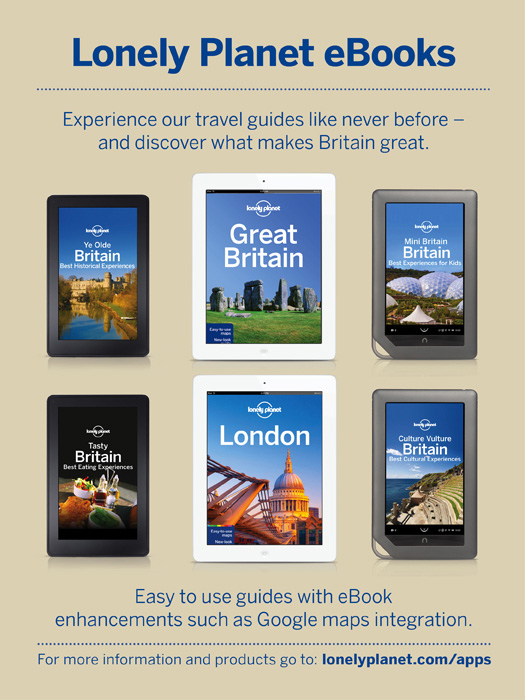Recession-Busting Britain: Best Free Experiences
Keeping an eye on the pennies is a good idea at any time, but at the moment its even more important than usual which is why weve produced this Lonely Planet guide to seeing the best Britain has to offer where you dont need to spend anything. Across the whole of the country weve picked out those places that can be enjoyed without worrying about the cost (a cup of tea and a scone or two not included).
To help you find your way around this ebook weve divided the country into eight different regions: . Weve listed towns and cities within each region alphabetically.

London
Forget all those stories about how expensive London is. If you know the right places, you can enjoy the capital for free. Home to many national (and therefore free) collections, Londons also well served by parks and gardens for leisurely strolling, and markets and shops for (window) shopping.
Big-Name Museums & Galleries
British Library
(www.bl.uk; 96 Euston Rd NW1;  9.30am-6pm Mon & Wed-Fri, 9.30am-8pm Tue, 9.30am-5pm Sat, 11am-5pm Sun;
9.30am-6pm Mon & Wed-Fri, 9.30am-8pm Tue, 9.30am-5pm Sat, 11am-5pm Sun;  Kings Cross St Pancras) You need to be a reader (ie member) to use the vast collection of the library, but the Treasures gallery is open to everyone. Here youll find Shakespeares first folio, Leonardo da Vincis notebooks, the lyrics to A Hard Days Night scribbled on the back of Julian Lennons birthday card, Oscar Wildes handwritten Ballad Of Reading Gaol, religious texts from around the world and, most importantly, the 4th-century Codex Sinaiticus (one of the earliest Bibles) and 1215 Magna Carta.
Kings Cross St Pancras) You need to be a reader (ie member) to use the vast collection of the library, but the Treasures gallery is open to everyone. Here youll find Shakespeares first folio, Leonardo da Vincis notebooks, the lyrics to A Hard Days Night scribbled on the back of Julian Lennons birthday card, Oscar Wildes handwritten Ballad Of Reading Gaol, religious texts from around the world and, most importantly, the 4th-century Codex Sinaiticus (one of the earliest Bibles) and 1215 Magna Carta.
British Museum
(www.britishmuseum.org; Great Russell St WC1;  10am-5.30pm Sat-Wed, to 8.30pm Thu & Fri;
10am-5.30pm Sat-Wed, to 8.30pm Thu & Fri;  Russell Sq) The countrys largest museum and one of the oldest and finest in the world, the BM boasts vast Egyptian, Etruscan, Greek, Roman, European and Middle Eastern galleries, among many others. Begun in 1753 with a cabinet of curiosities bequeathed by Sir Hans Sloane to the nation on his death, the collection mushroomed over the ensuing years partly through the plundering of the empire. The grand Enlightenment Gallery was the first section of the redesigned museum to be built (in 1823).
Russell Sq) The countrys largest museum and one of the oldest and finest in the world, the BM boasts vast Egyptian, Etruscan, Greek, Roman, European and Middle Eastern galleries, among many others. Begun in 1753 with a cabinet of curiosities bequeathed by Sir Hans Sloane to the nation on his death, the collection mushroomed over the ensuing years partly through the plundering of the empire. The grand Enlightenment Gallery was the first section of the redesigned museum to be built (in 1823).
Among the must-sees are the Rosetta Stone, the key to deciphering Egyptian hieroglyphics, discovered in 1799; the controversial Parthenon Sculptures, stripped from the walls of the Parthenon in Athens by Lord Elgin (the British ambassador to the Ottoman Empire), and which Greece wants returned; the stunning Oxus Treasure of 7th- to 4th-century-BC Persian gold; and the Anglo-Saxon Sutton Hoo burial relics.
The Great Court was restored and augmented by Norman Foster in 2000 and now has a spectacular glass-and-steel roof, making it one of the most impressive architectural spaces in the capital. In the centre is the Reading Room, with its stunning blue-and-gold domed ceiling, where Karl Marx wrote the manifesto of the Communist Party.
Youll need multiple visits to savour even the highlights here; happily there are 15 half-hour free eye opener tours between 11am and 3.45pm daily, focusing on different parts of the collection. Other tours include the 90-minute highlights tour at 10.30am, 1pm and 3pm daily (adult/child 8/5). Audioguides are available (4.50).
Imperial War Museum
(www.iwm.org.uk; Lambeth Rd SE1;  10am-6pm;
10am-6pm;  Lambeth North) You dont have to be a lad to appreciate the Imperial War Museum and its spectacular atrium with Spitfires hanging from the ceiling, rockets (including the massive German V2), field guns, missiles, submarines, tanks, torpedoes and other military hardware. Providing a telling lesson in modern history, highlights include a recreated WWI trench and WWII bomb shelter as well as a Holocaust exhibition.
Lambeth North) You dont have to be a lad to appreciate the Imperial War Museum and its spectacular atrium with Spitfires hanging from the ceiling, rockets (including the massive German V2), field guns, missiles, submarines, tanks, torpedoes and other military hardware. Providing a telling lesson in modern history, highlights include a recreated WWI trench and WWII bomb shelter as well as a Holocaust exhibition.
Museum of London
(www.museumoflondon.org.uk; 150 London Wall EC2;  10am-6pm:
10am-6pm:  Barbican) Visiting the fascinating Museum of London helps make sense of the layers of history that make up the city. The Roman section, in particular, illustrates how the modern is grafted onto the ancient; several of the citys main thoroughfares were once Roman roads, for instance. The museums 20 million Galleries of Modern London opened in 2010, encompassing everything from 1666 (the Great Fire) to the present day. While the Lord Mayors ceremonial coach is the centrepiece, an effort has been made to create an immersive experience: you can enter reconstructions of an 18th-century debtors prison, a Georgian pleasure garden and a Victorian street.
Barbican) Visiting the fascinating Museum of London helps make sense of the layers of history that make up the city. The Roman section, in particular, illustrates how the modern is grafted onto the ancient; several of the citys main thoroughfares were once Roman roads, for instance. The museums 20 million Galleries of Modern London opened in 2010, encompassing everything from 1666 (the Great Fire) to the present day. While the Lord Mayors ceremonial coach is the centrepiece, an effort has been made to create an immersive experience: you can enter reconstructions of an 18th-century debtors prison, a Georgian pleasure garden and a Victorian street.
National Gallery
(www.nationalgallery.org.uk; Trafalgar Sq WC2;  10am-6pm Sat-Thu, to 9pm Fri;
10am-6pm Sat-Thu, to 9pm Fri;  Charing Cross) Gazing grandly over Trafalgar Sq through its Corinthian columns, the National Gallery is the nations most important repository of art. Four million visitors come annually to admire its 2300-plus Western European paintings, spanning the years 1250 to 1900.
Charing Cross) Gazing grandly over Trafalgar Sq through its Corinthian columns, the National Gallery is the nations most important repository of art. Four million visitors come annually to admire its 2300-plus Western European paintings, spanning the years 1250 to 1900.
Highlights include Turners The Fighting Temeraire (voted Britains greatest painting), Botticellis Venus and Mars and Van Goghs Sunflowers. The medieval religious paintings in the Sainsbury Wing are fascinating, but for a short, sharp blast of brilliance, you cant beat the truckloads of Monets, Manets, Czannes and Renoirs in rooms 43 to 46.
Natural History Museum
(www.nhm.ac.uk; Cromwell Rd SW7;  10am-5.50pm;
10am-5.50pm;  South Kensington) A sure-fire hit with kids of all ages, the Natural History Museum is crammed full of interesting stuff, starting with the giant dinosaur skeleton that greets you in the main hall. In the dinosaur section, the fleshless fossils are brought to robotic life with a very realistic 4m-high animatronic Tyrannosaurus rex and his smaller, but no less sinister-looking, cousins.
South Kensington) A sure-fire hit with kids of all ages, the Natural History Museum is crammed full of interesting stuff, starting with the giant dinosaur skeleton that greets you in the main hall. In the dinosaur section, the fleshless fossils are brought to robotic life with a very realistic 4m-high animatronic Tyrannosaurus rex and his smaller, but no less sinister-looking, cousins.
The other galleries are equally impressive. An escalator slithers up and into a hollowed-out globe where two exhibits The Power Within and Restless Surface explain how wind, water, ice, gravity and life itself affect the earth. For parents unsure of how to broach the facts of life, a quick whiz around the Human Biology section should do the trick.
The Darwin Centre houses a team of biologists and a staggering 20-million-plus species of animal and plant specimens. Take a lift to the top of the Cocoon, a seven-storey egg-shaped structure encased within a glass pavilion, and make your way down through the floors of interactive displays. Glass windows allow you to watch the scientists at work.
















 9.30am-6pm Mon & Wed-Fri, 9.30am-8pm Tue, 9.30am-5pm Sat, 11am-5pm Sun;
9.30am-6pm Mon & Wed-Fri, 9.30am-8pm Tue, 9.30am-5pm Sat, 11am-5pm Sun;  Kings Cross St Pancras) You need to be a reader (ie member) to use the vast collection of the library, but the Treasures gallery is open to everyone. Here youll find Shakespeares first folio, Leonardo da Vincis notebooks, the lyrics to A Hard Days Night scribbled on the back of Julian Lennons birthday card, Oscar Wildes handwritten Ballad Of Reading Gaol, religious texts from around the world and, most importantly, the 4th-century Codex Sinaiticus (one of the earliest Bibles) and 1215 Magna Carta.
Kings Cross St Pancras) You need to be a reader (ie member) to use the vast collection of the library, but the Treasures gallery is open to everyone. Here youll find Shakespeares first folio, Leonardo da Vincis notebooks, the lyrics to A Hard Days Night scribbled on the back of Julian Lennons birthday card, Oscar Wildes handwritten Ballad Of Reading Gaol, religious texts from around the world and, most importantly, the 4th-century Codex Sinaiticus (one of the earliest Bibles) and 1215 Magna Carta.